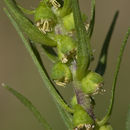Description
provided by eFloras
Annuals, (10–)50–100(–150+) cm. Stems erect. Leaves: petioles 5–20(–30) mm; blades deltate or ovate to elliptic, trullate, or lanceolate, 30–100(–150+ × 8–45(–80) mm, margins ± toothed, faces ± scabrellous, gland-dotted. Heads in ± spiciform arrays. Peduncles 0–1 mm. Involucres ± hemispheric, 3–4(–5) mm. Phyllaries: outer 3–5 distinct, ± herbaceous. Paleae linear, 2–2.5 mm. Pistillate florets 3–5; corollas 0.5–1 mm. Functionally staminate florets 8–12+; corollas 2–2.5 mm. Cypselae 2–3 mm. 2n = 34.
- license
- cc-by-nc-sa-3.0
- copyright
- Missouri Botanical Garden, 4344 Shaw Boulevard, St. Louis, MO, 63110 USA
Synonym
provided by eFloras
Iva annua var. caudata (Small) R. C. Jackson; I. annua var. macrocarpa (S. F. Blake) R. C. Jackson
- license
- cc-by-nc-sa-3.0
- copyright
- Missouri Botanical Garden, 4344 Shaw Boulevard, St. Louis, MO, 63110 USA
Comprehensive Description
provided by North American Flora
Iva ciliata Wilid. Sp. PI. 3: 2386. 1804
Iva annua Michx. Fl. Bor. Am. 2: 184. 1803. Not I. annua L. 1753. Ambrosia Pitcheri Torr.; Hook. Comp. Bot. Mag. 1 :99. 1835. Iva ciliata latifolia DC. Prodr. 5: 529. 1836.
A rather stout annual; stem 5-20 dm. high, angled, striate, hispidulous and hispid; leaves, except the uppermost, opposite; petioles hispid, 1-2 cm. long; blades ovate or the upper lanceolate, 3-10 cm. long, triple-ribbed, hispidulous and glandular-punctate on both sides, acuminate, dentate or subentire; heads in elongate spikes, terminating the stem and branches; floral leaves ovate to lanceolate, acuminate, hispidulous on the back, and hispid-ciliate on the margins; involucre turbinate, about 5 mm. broad; bracts 3 or 4 (rarely 5), cuneate, rounded or truncate at the apex, hispid on the back and hispid-ciliate; paleae of the receptacle filiform with clavate tips; staminate flowers 10-15; tips of anthers acute, inflexed; style about half as long as the stamens; stigma penieillate; pistillate flowers 3-5; aehenes 2.5-3 mm. long, dark-brown, murieulate and towards the apex hispidulous, broadly obovate, lenticular.
Type locality: North America.
DISTRIBUTION: Alluvial soil, from Illinois to Nebraska, New Mexico, and Louisiana; introduced in Maine and Massachusetts.
- bibliographic citation
- Per Axel, Rydberg. 1922. CARDUALES; AMBROSIACEAE, CARDUACEAE. North American flora. vol 33(1). New York Botanical Garden, New York, NY
Comprehensive Description
provided by North American Flora
Iva caudata Small, Bull. N. Y. Bot. Gard. 1: 290. 1899
Iva annua Lam. Tab. Kncyc. 3: 354, 1823. Not I. annua L. 1753. Ambrosia Pitcheri (i Hook. Comp. Bot. Mag. 1: 100. 1835. Iva ciliata T. & G. Fl. N. Am. 2: 287. 1842.
A tall annual; stem 4-10 dm. high, branched, angled, hispid and strigose-hispidulous; leaves mostly opposite; petioles 1-2 cm. long, hispid; blades ovate or elliptic, lanceolate, rather thin, triple-ribbed, 4-10 cm. long, coarsely serrate-dentate, acuminate, hispidulous and glandular-punctate on both sides; heads in spikes, terminating the stem and branches; floral leaves linear or linear -lanceolate, 7-15 mm. long, caudate-acuminate, hispidulous, but hispid-ciliate only near the base; involucre tuibinate, about 5 mm. broad; bracts usually 3, cuneate, hispidciliate; paleae of the receptacle filiform with clavate tips; staminate flowers 10-15; corolla funnelform; anthers with acute tips; pistillate flowers 3-5; aehenes broadly obovate, murieulate, dark-brown.
Type locality: Louisiana.
Distribution: Southern Illinois and Missouri to Mississippi and Louisiana.
- bibliographic citation
- Per Axel, Rydberg. 1922. CARDUALES; AMBROSIACEAE, CARDUACEAE. North American flora. vol 33(1). New York Botanical Garden, New York, NY
Iva annua: Brief Summary
provided by wikipedia EN
Iva annua, the annual marsh elder or sumpweed, is a North American herbaceous annual plant in the family Asteraceae that was historically cultivated by Native Americans for its edible seed.
- license
- cc-by-sa-3.0
- copyright
- Wikipedia authors and editors

